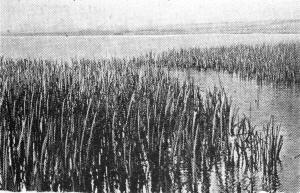Newspaper article from 1931
AN INLAND FYLDE LAKE
CENTURIES OLD
How many people, I wonder, are aware that
the Fylde possesses a great expanse of water which comparatively few residents have
ever seen, and of which some may even never have heard. Next year; when the
boundaries of the borough are extended, the Mere will come within the confines of
Blackpool.
Marton Mere figured in history long before Blackpool existed. Much of the famous
Mere's glory has departed front it. It is now an insignificant dozen or so acres,
whereas we are told that in ancient days it was six miles long and at least one and
a half miles wide.

It certainly figures conspicuously on the map of the Fylde
published by John Speed, of London, early in the 17th century, and a stream is
shown connecting the Mere with the sea at what is now Blackpool.
On the map, too, from the Mere right along, the coast to the mouth of the Ribble is
described as Marton Moss, which is probably the great moss mentioned in the charter
for the foundation of the Lytham Priory in the reign of Richard I.
Fishing Rights
One wonders if those old monks of the Cell
of Lethum ever used to go fishing in that great Mere for their Friday's dinner, or
were they content with the salmon from the Ribble and the fish from the
sea?
As long ago as the 13th century, we are told that Theobald
Walter (le Bo- teller) granted to the abbots of Stanlawe the right to make a pool
out of ;Marten mere or marsh, and to take the water to their mill at Staining. with
a ' proviso that the fish in the said more were not to he injured. A little later
the Earl of Ormond, James, son of Edward le botelier, held the fishery called
Marton Mere, paving yearly for it at Michaelmas ten shillings and one soar
hawk.
It is asserted by one historian that the right of fishing In
the Mere formed the subject of litigation in the reign of Edward III, but no
authority is quoted for this statement.
Anglers' Paradise
In the reign of Henry VIII, Thomas Hesketh
and Richard Banester fought an action in the Duchy Court over the right of fishing
in Marton Myre, and about 1589 John Singleton of Staining, held the privilege of
fishing in the Mere.
It is quite evident that at that period of history Marton Mere brought joy to the
hearts of anglers.
I can well imagine one local parson at least, if he had lived
in those bygone days, sitting happy and content for hours, in his monkish habit by
the side of Marton Mere, fishing rod in hand, endeavouring to tempt enough fish to
leave the security of the cool waters of the Mere, to provide a substantial dinner
for fast days for his fellow monks at the Priory at Lethum. Tradition states that a
stream which issued from Marton Mere formerly turned the wheel of a Water mill near
to the village of Great Marton. Thornber describes it as an undeniable fact, for in
1657 it was in the occupation of Margaret Butler, and in 1683 under the management
of one Wilkins.
Mere Overflows
In 1731 the overflowing of the Mere
evidently caused considerable annoyance and loss to the owners of land in the
neighbourhood, and an agreement was entered into between them and Edward Jolly of
Marton, for him to clean widen and sink the watercourse "which goes or runs from
the north end of the Mere eastwards, and so in its circuit and several turnings
through Weeton cum-Preese, Hardhorn-cum-Newton. and Singleton to Skippoole and
thence the River Wyer."
Ten years later we find other land-owners stating that by an
Order from a Court of Sewers they are ordered to widen the ditch running front
"Martin Mear" to Mythop or Preese Carr to two yards and a half at the bottom, and
agreeing that William Jolly should do the work.
During the work of draining the Mere large quantities of tree
trunks of oak and yew trees were found in the soil, all of which were in a slanting
position towards the sea.
Thornber expresses the opinion that far back in history the whole district was
covered by a great forest which was overwhelmed by the sea before the Roman
conquest, and he says that in cutting the main dyke a person named E. Jolly found
coracles, which were taken to Poulton, and which probably belonged to the ancient
Britons who lived in this district in those far away days.
Contrasts
Now, through drainage and the gradual
accumulation of sediment, the mere has shrunk to a comparatively insignificant
sheet of water compared with centuries ago, and it forms part of the area which was
acquired by the Corporation for the construction of the aerodrome and racing track
under the Act of 1928.
What a great step front those distant days to the present age of great air liners
and racing motor cars which attain a speed of four miles a minute.
One can imagine the look of consternation which would have spread over the faces of
those old Fyldeans if a great bird, such as we often see nowadays, had swooped down
from the blue skies while they were calmly fishing by the great Mere of Marton or
hawking over the peaceful fields.
I am afraid they would have been too surprised for some time to see if they had got
a bite, even if they had not jumped into the Mere in panic.
And, whisper it in the hearing of ardent anglers, there are still fish in Marton
Mere, even if it has shrunk in size.
|